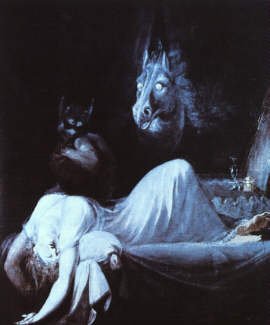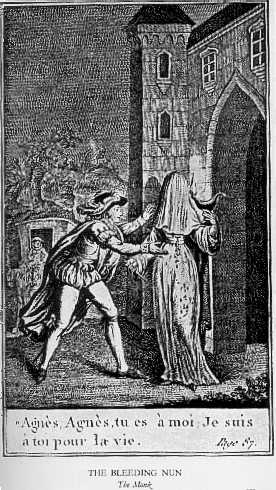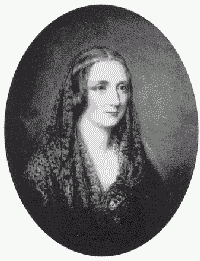Lecture VI--Science and Fiction: Mary Shelley and the Frankenstein Legacy
In the sixth class session we will examine some of the late Eighteenth, early Nineteenth Century ideas about religion, gender, individual freedom, and emerging science that influenced women writers. Mary Shelley's Frankenstein is one of the most popular science fiction stories ever - and it epitomizes the blend of scientific speculation, gothic horror, and personal responsibility that tend to characterize many novels written by women in the centuries to come. You have been reading Mary Shelley's Frankenstein (we will usually be reading ahead, that is, your reading will precede the lecture). The character of Dr. Frankenstein, and his poor monster, have been altered considerably in popular recreations - folklore, comic books, and the like. A closer study reveals that this story arose directly out of scientific ideas of the time, such as the work of Galvani, and takes as its subject, in imaginative form, the responsibility we have for the creatures we create. Thus, religion, science, and, yes, motherhood are all interrogated in this first "horror" story.
By Henri
Fuseli (Swiss; practiced in England, 1741-1825) Feature: Unknown Writer of the Week Ann Radcliffe From The Italian, Chapter 1. It was nearly midnight, and the stillness that reigned was rather soothed than interrupted by the gentle dashing of the waters of the bay below, and by the hollow murmurs of Vesuvius, which threw up, at intervals its sudden flame on the horizon, and then left it to darkness. The solemnity of the scene accorded with the temper of his mind, and he listened in deep attention for the returning sounds, which broke upon the ear like distant thunder muttering imperfectly from the clouds. The pauses of silence, that succeeded each groan of the mountain, when expectation listened for the rising sound, affected the imagination of Vivaldi at this time with particular awe, and, rapt in thought, he continued to gaze on the sublime and shadowy outline of the shores, and on the sea, just discerned beneath the twilight of the cloudless sky. Along its grey surface many vessels were pursuing their silent course, guided over the deep waters only by the polar star, which burned with steady lustre. The air was calm, and rose from the bay with most balmy and refreshing coolness; it had scarcely stirred the heads of the broad pines that overspread the villa; and bore no sounds but of the waves and the groans of the far-off mountain,--till a chaunting of deep voices swelled from a distance. The solemn character of the strain engaged his attention; he perceived that it was a requiem, and he endeavoured to discover from what quarter it came. Forerunners of Mary Shelley: the Gothic Sensibility Ann Radcliffe - The Gothic Romance Mary and Mary: Mother and Daughter Science in 1800 The Real Life of Mary Shelley A Smooth Path?
Forerunners of Mary Shelley: the Gothic Sensibility The Gothic Sensibility is part of the Romantic Movement in general, and in the case of literature, tends to be a forerunner of the full-blown Romantic Movement that includes the names we are familiar with - Byron, Keats, Shelley (Percy), and so forth (men). The kind of Romanticism that arose at the end of the 18th Century is not the romance genre writing that we associate with "bodice rippers" of today, although they are distantly related. The Romantic Movement of two centuries ago took a rather well-defined position against "rationalism" - and works tended to stress the following: Romanticism emphasized the individual, the subjective, the
irrational, the imaginative, the personal, the spontaneous, the emotional, the visionary, and the transcendental.
Among the characteristic attitudes of Romanticism were the following: a deepened appreciation of the beauties of nature; a
general exaltation of emotion over reason and of the senses over intellect; a turning in upon the self and a heightened examination
of human personality and its moods and mental potentialities; a preoccupation with the genius, the hero, and the exceptional
figure in general, and a focus on his passions and inner struggles; a new view of the artist as a supremely individual creator,
whose creative spirit is more important than strict adherence to formal rules and traditional procedures; an emphasis upon
imagination as a gateway to transcendent experience and spiritual truth; an obsessive interest in folk culture, national and ethnic
cultural origins, and the medieval era; and a predilection for the exotic, the remote, the mysterious, the weird, the occult, the
monstrous, the diseased, and even the satanic. The Gothic novel dominated English literature from its conception in 1764 with the publication of
The Castle of Ortanto by Horace Walpole has been continually criticized by numerous critics for its sensationalism, melodramatic qualities, and its play on the supernatural. Well, I tend to disagree with Franz, because the Gothic Genre did not really fade, it had a long adulthood in the Victorian Gothics and the Late Victorian Horror novels. We will talk about these a little later on, tho.
Ann Radcliffe - The Gothic Romance Radcliffe's Published Books You will notice with Ann Radcliffe that we are moving toward that peculiar definition that will characterize one of the most popular "patterns" of modern women writers - the recluse. While Aphra Behn was clearly a social individual (and fits into our pattern of Courtier), we are now moving in to the "new nuns" - the Brontes, Emily Dickinson, etc. etc. It is a curious coincidence of literary history that the stars that reigned in the year of the nativity of
The Castle of Otranto (1764) saw the birth of Mrs.Ann Radcliffe (Ward), in whose works we perceive the Gothic fiction approaching its meridian. Not much is known about her life, except that she was the wife of an Oxford graduate, and that she wrote her weird and mysterious tales beside a blazing fire in a quiet room to enliven her long, solitary winter evenings. Extraordinary fascinating stories flowed from her pen which, with all their faults, unmistakably bear the stamp of genius. The name of this potent enchantress, who touched the secret springs of fear and extended the domain of romance, was felt as a spell by her admirers, and to this day her blood-curdling terrors freeze many
a midnight reader. see more about Gothic Literature on The Gothic Literature Page Mary and Mary: Mother and Daughter
Mary Wollstonecraft Biographical Information about Mary Wollstonecraft Novel by MARY WOLLSTONECRAFT AUTHOR'S PREFACE The beginning of the Novel: ABODES OF HORROR have frequently been described, and castles, filled
with spectres and chimeras, conjured up by the magic spell of genius to harrow the soul, and absorb the wondering mind. But, formed of
such stuff as dreams are made of, what were they to the mansion of despair, in one corner of which Maria sat, endeavouring to recall
her scattered thoughts! The relationship between Mary Wollestonecraft and Mary Shelley is interesting in many ways. We have, first, the broken bond between mother and child, Mary Godwin's adulation of her Mother, and the trauma of an unsympathetic stepmother. But there is far more linking them, strangely enough, in their writing. Mary Shelley, in many ways, continues with the major concerns of her Mother. This issues show up everywhere in Frankenstein. Science in 1800 The Real Life of Mary Shelley A Smooth Path?
|
|
|
Literature 45 - Women in Literature : Marjorie C. Luesebrink, MFA Contents: Announcements // Discussion Page // About Your Class // Class Syllabus // Lecture Notes // Discussion Group // Reading List // Recommended Reading // Assignments // Resources and Web Sites // Grading Policies // Contact Your Instructor
|



